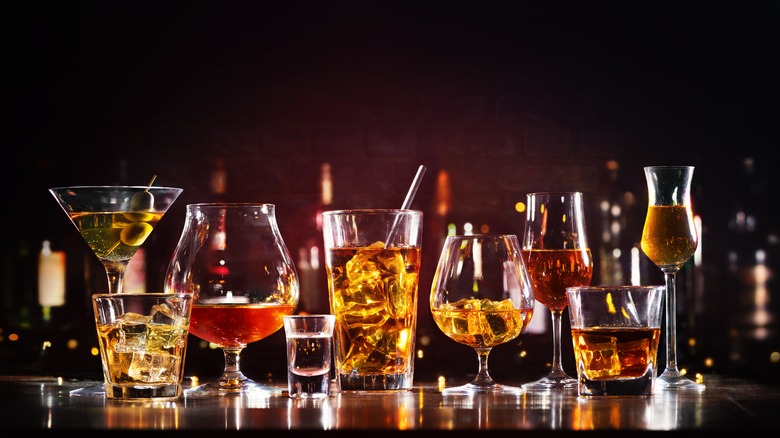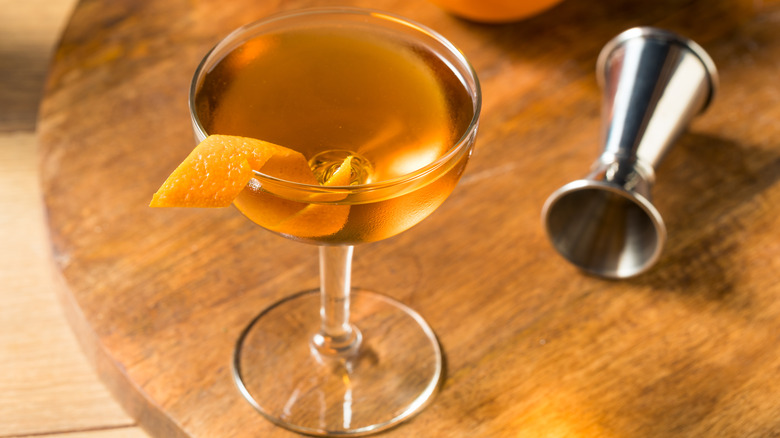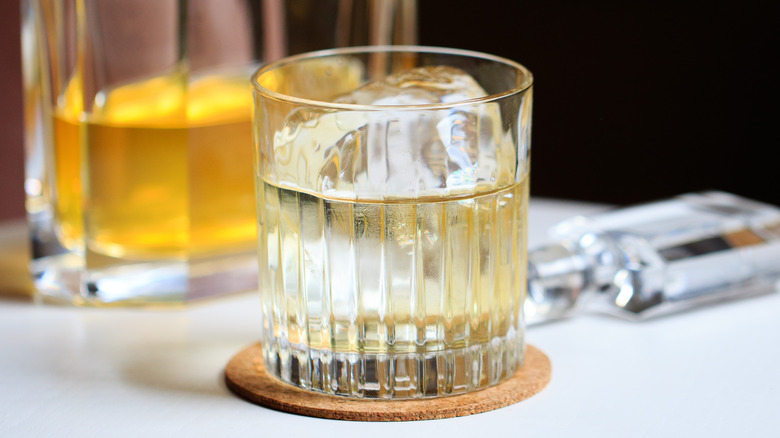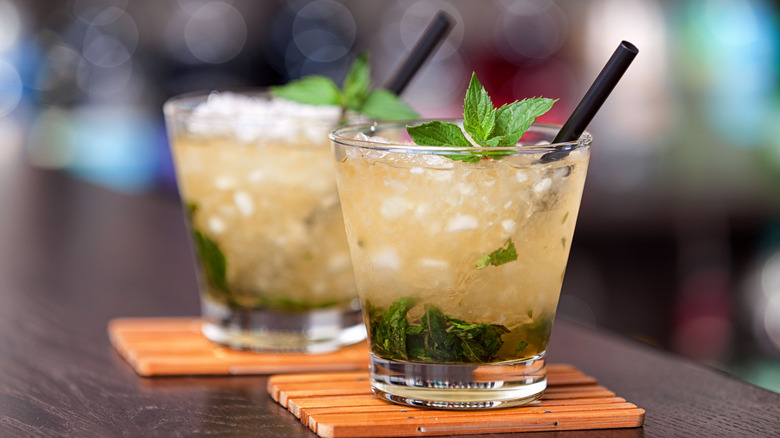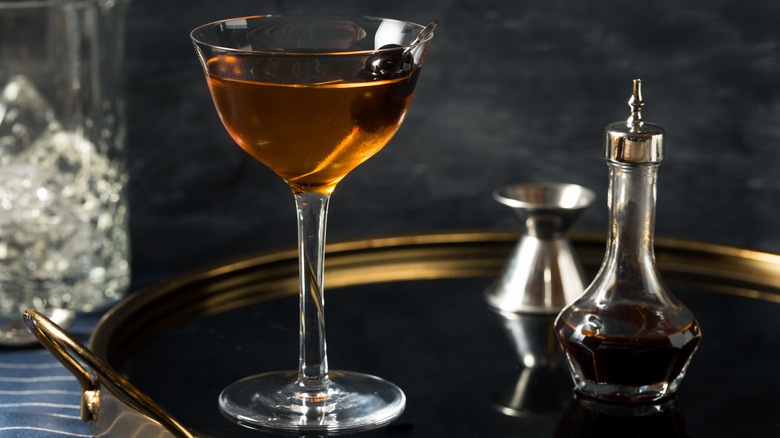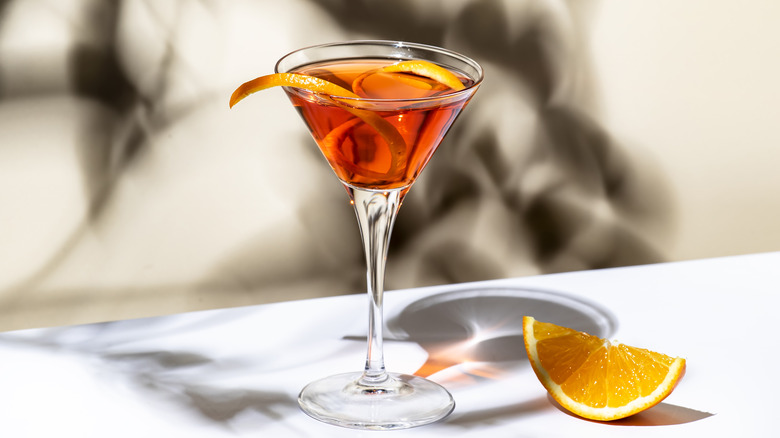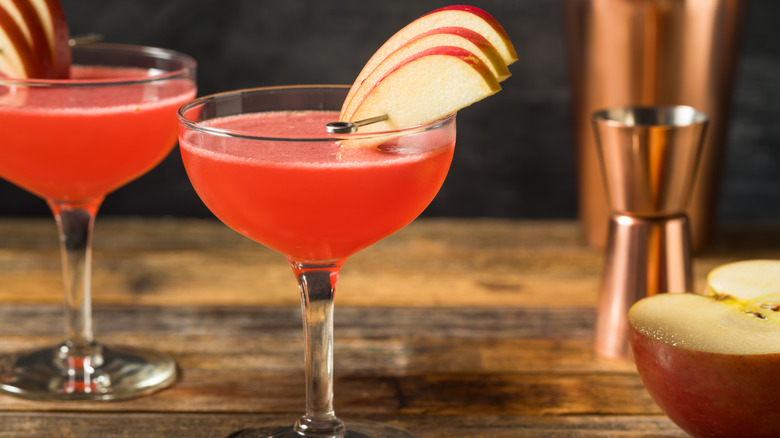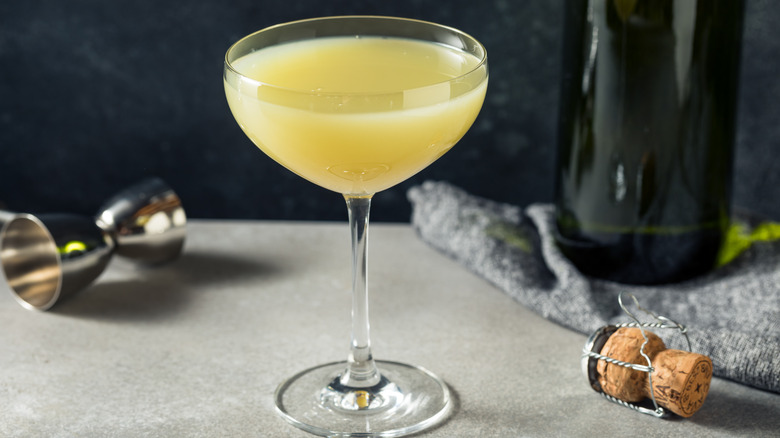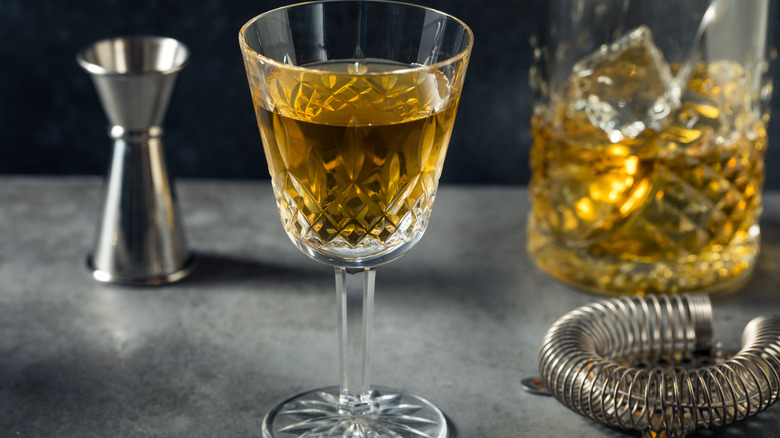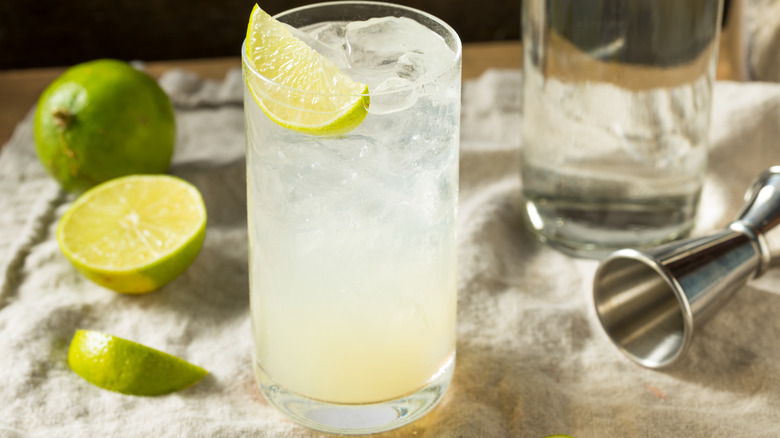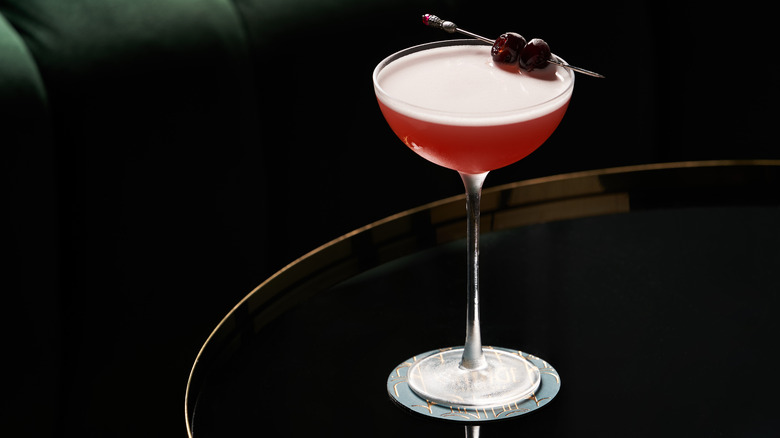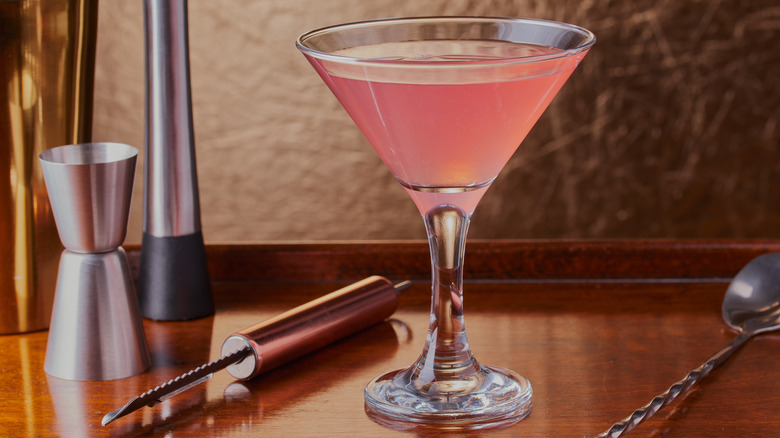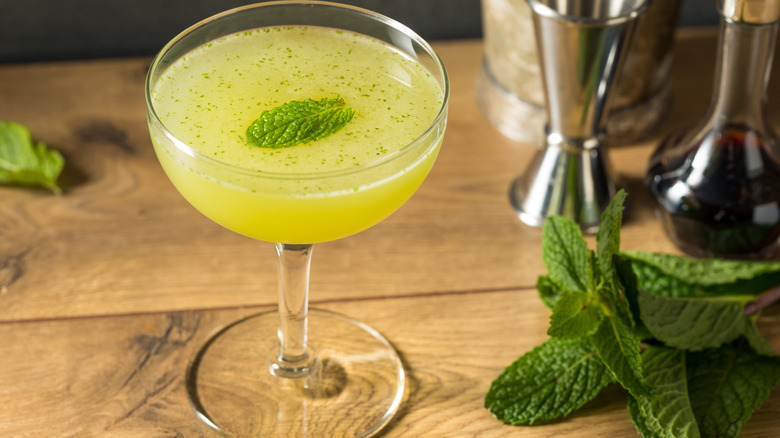12 Historical Cocktails That Will Fuel Your Party
If you're planning to have a party or go out on the town with your friends this weekend, it's likely that you'll drink a few cocktails together as you enjoy their company. And, you're not alone; According to a recent Gallup poll, about 65% of adults who are of legal drinking in the United States say they participate in drinking alcohol.
Creating alcoholic drinks is a longstanding human tradition dating all the way back to around 7000 B.C.. Since then and throughout history, bartenders, their patrons, and even famous celebrities have been creating their own concoctions of alcoholic beverages to enjoy. Even during Prohibition, when alcohol was banned in the United States for 13 years, underground speakeasies were whipping up creative cocktails with bootlegged booze. If you're looking for some inspiration to mix up something new at your next party, look no further than these fun, historical cocktail recipes.
Corpse Reviver
The Corpse Reviver is actually a series of numbered cocktails, each with their own unique elements. The original Corpse Reviver began circulating in the 1800s when it was prescribed as a hangover remedy. The original recipe printed in 1871 says that the drink is made of brandy, maraschino liqueur, and Boker's bitters and is served in a wine glass. From there, more iterations just kept coming. The Corpse Reviver #2 recipe, printed in 1930, is made with lemon juice, Kina Lillet, Cointreau, a dash of absinthe, and gin. Then, the Corpse Reviver #3 recipe printed in 1934 layers brandy, maraschino, and Curaçao. A 1937 iteration uses brandy, orange juice, and lemon juice topped with champagne. A 1956 rendition directs you to fill a highball glass with ice and pour in Pernod, lemon juice, and sparkling wine.
However you make your Corpse Reviver, be sure to drink it after a long night out to see if it revives you, just as the original creators intended. With so many differing variations, it's safe to say you can feel free to experiment to find a combination of flavors that makes you feel the most refreshed!
Milk Punch
If you've never heard of clarified milk punch before, you're probably wondering how something that allegedly contains milk comes out so translucent. Yes, there is actually milk involved in the milk punch creation process. However, not all of the milk makes it into your glass by the end. Milk punch is thought to have been invented back in the 1700s, though this is some argument over who exactly came up with the concept. The ingredients are simple, but the process can be a bit lengthy to carry out.
To make clarified milk punch, you first steep lemon peels in liquor, traditionally brandy. After letting the brandy absorb the lemon oils, you strain out the lemon peels. You then mix in lemon juice, sugar, and water and pour that brandy mixture into (preferably full-fat) milk. The lemon causes the milk to curdle, allowing you to separate the liquid from the curds. There is also some debate over whether the milk should be warm or cold, but it will work either way. The lengthy part of the process comes from the fact that you must let the lemon peels sit in the brandy for 48 hours to make sure the liqueur is infused enough. You also cannot separate out the milk curds immediately, and most recipes advise letting the mixture sit curdling for over an hour. However, after this lengthy process is done, you will be rewarded with a smooth, creamy-tasting drink that forgoes the cloudiness and heaviness of milk.
Mint Julep
These days, mint juleps are commonly associated with the Kentucky Derby horse race, which takes place each spring. The drink actually has a long history on its own. Like the Kentucky Derby, the mint julep originates from the southern United States. The first mention of the mint julep in print occurred in London in 1803, where it is mentioned that the drink originated from Virginia. Juleps are made up of mint, sugar, and crushed ice mixed with a spirit. These days, the common spirit to use is bourbon, but traditionally rum or cognac was used.
Over the years, juleps have only grown in popularity, and there are even special, metal julep cups that often house the drink. However, likely one of the biggest reasons that mint juleps have maintained modern popularity is that since 1938 they have been the official drink of the Kentucky Derby. While mint juleps are certainly the perfect Derby Day drink, they are really a perfect fit for any hot summer day.
Widow's Kiss
The Widow's Kiss cocktail recipe was first published in a book called "Modern American Drinks" in 1895. (Interestingly, this same book also contains the first publication of the recipe for an Old Fashioned, a classic cocktail that is still popular today.) The recipe for a Widow's Kiss is rather simple: It is made up of apple brandy, Bénédictine, and yellow Chartreuse, with a few dashes of Angostura bitters. The original recipe as written is rather sweet, as it was originally intended to be an after-dinner drink, and therefore has an almost dessert-like quality to it.
These days, it is common to change the ratio of the ingredients to make the cocktail less sweet. Additionally, sometimes green Chartreuse is substituted for yellow Chartreuse, but both liqueurs can be difficult to find because the monks who produce them have capped production at 1.6 million bottles per year. If you get your hands on a bottle of the liqueur, made with a secret recipe of 130 herbs and botanicals, the Widow's Kiss is the perfect cocktail to help it shine.
Martinez
The Martinez cocktail is said to have functioned as a bridge between the creation of the Manhattan cocktail and the creation of the Martini. It was likely created in the 1860s or 1870s, but the recipe was first printed in an 1884 book called "The Modern Bartender," which lists it as a twist on the Manhattan. Generally, the drink contains gin, vermouth, and Angostura bitters, with different mix-ins for different variations, such as maraschino liqueur or blue Curaçao.
Whether you should use sweet or dry vermouth and what kind of gin you should use tend to be points of debate among Martinez cocktail fans. Many recipes use either type of vermouth or even a little bit of both. As far as the gin debate goes, back when the Martinez was created, Dutch genever or old tom gin were likely used. However, in modern times, many people already have London dry gin in their home bar, so it is often used instead.
Jack Rose
Like many fun creations throughout history, there are several differing theories about how and why the Jack Rose cocktail was invented. Some believe it was named after New York's Bald Jack Rose, a gambler who received a lot of public attention in the early 1900s. Another theory states that it was actually invented by a restaurateur named Joseph P. Rose. Still, others believe that it is named after a French flower called the pink Jacqueminot rose. The drink was extremely popular in the 1920s and 1930s, and it is even mentioned in Ernest Hemingway's "The Sun Also Rises."
Regardless of the drink's true origin, it is a great, simple, three-ingredient cocktail that also looks beautiful. The basic recipe calls for applejack (an apple brandy), grenadine, and lime or lemon juice. Some recipes also replace the grenadine with Chambord, which will result in a deeper color rather than the typical shade of bright pink. Either way, the cocktail is light, sweet, and easy to drink, making it great for parties and gatherings.
Death in the Afternoon
The legendary author Ernest Hemingway is responsible for the Death in the Afternoon cocktail, which shares a name with one of his books. The recipe was first published in a 1935 book of recipes that were created by 30 different popular authors of the day. The beauty in the recipe may just be its utter simplicity. It calls for only two ingredients: absinthe and champagne. And, you won't find any fancy shaking or stirring instructions here. You simply pour a jigger of absinthe into a glass and top it with chilled champagne.
While the recipe may seem so simple that some may even consider it boring, at the time, that was far from the truth. In the early 1900s, absinthe had become quite a controversial spirit due to the fact that it contained wormwood, which some believed to be tied to impotence. This led to absinthe being banned in some places, and the wormwood eventually being removed from the recipe altogether to get the bans lifted. Luckily, these days you can easily find absinthe on your local liquor store's shelves and make a toast to Hemingway's simple, controversial creation.
Bijou
Dating back to 1862, the "fancy gin cocktail" served as a precursor for what would later be known as the Bijou cocktail. The 1862 fancy gin cocktail recipe contains gin, Curaçao, gum syrup, and bitters. Harry Johnson is then credited with publishing the first true Bijou cocktail recipe in the year 1900. This recipe contained gin, Italian vermouth, green Chartreuse, and orange bitters. The ingredients are stirred together with ice before being strained into a wine glass and commonly garnished with either a cherry or an olive.
This recipe was then played with in various ways by others, who removed the bitters, changed the garnish to an orange peel, swapped out the Chartreuse for Curaçao (as was used in the original fancy gin cocktail), and more. While most bars seemed to have their own special twist on the drink, the basic recipe today tends to follow Harry Johnson's, containing some combination of gin, vermouth, Chartreuse, and bitters. The result is a delicious, crisp, and herbaceous drink.
Gin Rickey
Interestingly, the origin story of the gin Rickey doesn't actually start with gin. In the late 1800s Colonel Joseph Rickey was a popular political figure in Washington, D.C. It's believed that Rickey invented the drink in the hot summer of 1883 when he was looking for a cool, refreshing drink to beat the heat. During this time, Colonel Rickey is said to have ordered a drink consisting of rye, fresh lime juice, and seltzer on ice in a D.C. bar. When he ordered another of the same drink, the bartender decided to name the drink after him.
The drink then began to gain popularity, and other Rickeys using other liquors started to enter the scene. This led to an entire family of Rickeys, all with various liquors substituted for the rye. While Colonel Rickey firmly stuck to his preference for the rye version, the gin Rickey eventually emerged victorious as the most popular form. It is still widely known today, and most people have no idea about its rye-based origin. The refreshing, botanical notes of gin serve as the perfect complement to the light, bubbly seltzer and tangy lime juice in a way the heavier, spicier rye just never did.
Mary Pickford
While the Mary Pickford cocktail was definitely inspired by the famous 1920s actress, writer, and producer of the same name, that's about all we know for sure of the drink's origin story. There are actually a number of rumors about exactly when and where the drink was invented. Some say it was invented when Pickford was on a trip to Cuba with her husband, Douglas Fairbanks, but records show no evidence of them going on such a trip together. However, the drink still may have been invented in Cuba without her presence, because it seems that the first printed recipe for the cocktail came out in a book published in 1928 titled "When It's Cocktail Time in Cuba." Prohibition meant that alcohol was outlawed in the United States at the time, so many bartenders moved to Cuba and lived there in the 1920s and early 1930s to continue their craft. This explains why a cocktail named after an American celebrity could easily have originated out of Cuba, even if she wasn't visiting at the time.
The drink's flavor profile is said to be like the personality of the actress herself: sweet upfront, but secretly packing a punch. The original recipe calls for a ratio of two-thirds of pineapple juice to one-third of rum (traditionally Bacardi) with a dash of grenadine added to give it a pretty pink color. In later iterations, maraschino liqueur is often added instead of grenadine to give the drink an even deeper pink hue.
Ward Eight
As is often the case with historical cocktails, there is some debate about how exactly the Ward Eight cocktail originated. What we do know is that it was invented in Boston sometime in the late 1800s or early 1900s. The most commonly agreed upon story states that the Ward Eight cocktail was created in 1898 by a bartender named Tom Hussion at a restaurant called Locke-Ober. As for its purpose, this story alleges that the drink was created to celebrate an election won by a political boss of North Boston named Martin "The Mahatma" Lomasney. Supposedly, the name was meant to honor the district that cinched his win. Other accounts claim that it was invented later or by a different bartender, so no one knows for sure how the drink came to be.
Unfortunately, guidance on how to correctly make the drink is not much clearer, and there are many different variations of recipes from the 1920s and 1930s floating around. However, most people agree that the Ward Eight cocktail is usually considered a play on a whiskey sour with grenadine added. In its most basic form, the drink usually contains whiskey, lemon juice, orange juice, and grenadine. This makes the drink very sweet and incredibly easy to sip and gives it an almost sunset-like, orange-pink color.
The Southside
There are two main stories that serve as possible origins of the Southside cocktail. In a 1917 book called "Recipes for Mixed Drink," a recipe for a drink called a Southside Fizz is included. The recipe does bear some resemblance to the Southside cocktail, but it contained both lemon and lime juice (the Southside usually contains one or the other), and it was topped with soda water (hence the "fizz" in the name). This places the cocktail's origin right before Prohibition. However, there is another, perhaps more exciting tale involving Prohibition and Al Capone. This story states that during Prohibition, notorious gangster Al Capone and his crew had control over the illegal alcohol trade on the south side of Chicago. The gin that they were smuggling in was said to be very harsh and hard to drink, so they used sugar and citrus juices to mask the unpleasant taste. This recipe was then named the Southside, after their territory.
Regardless of the cocktail's origin, the end result is certainly delicious. Today, the drink is usually made using gin, lemon or lime juice (depending on the flavor profile of the gin), simple syrup, and mint. If the rumors are true and the drink was originally created to mask the taste of bad gin, it ended up as a sweet, refreshing, and desirable cocktail. We may be buying our gin from regulated manufacturers these days, but the Southside cocktail is still a worthy addition to your bar rotation.

